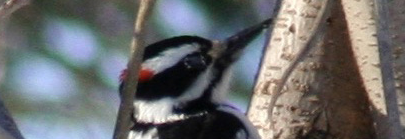Woodpeckers are fascinating birds which are widely known for their method of gathering food. They use their sturdy beaks to drill holes in tree bark to find their insect prey, and to chisel nest holes in dead wood. Though the prairie is most closely identified with grasslands, there are multiple species of trees that are native to the area, and that’s where woodpeckers are found.
Woodpeckers are a part of the Picidae family, which also includes piculets, wrynecks, and sapsuckers. While according to the Handbook of Birds of the World there are 254 species of woodpeckers, which come in a wide variety of shapes, sizes, and colors, there are seven species that call the prairie region home.These include northern flickers, yellow-bellied sap suckers, and downy, hairy, pileated, red-bellied, and red-headed woodpeckers. These birds are non-migratory, though some temperate-region species do shift their range for warmth. Their diet mostly consists of insects, but some also feed on fruits and berries.
Woodpeckers are found throughout the world except for Australasia, Madagascar, and Antarctica, as well as some of the oceanic islands.
Frequent Rootstalk contributor Sandy Moffett took the photographs which accompany this feature, capturing all the images near his home in Poweshiek County, Iowa. The yellow-bellied sapsucker is the only local woodpecker that has eluded his camera so far, and it is the only species missing from this issue’s “Birds of the Prairie” special feature.
Woodpeckers of the Prairie: Red-Headed Woodpecker
Melanerpes erythrocephalus
The red-headed woodpecker is characterized by its bright-red head, neck, throat, and upper breast; blue-ish black wings and tail; and large white square areas on the rear part of its wings and upper rump. They are monogamous and territorial, with an average life expectancy of 119 months.
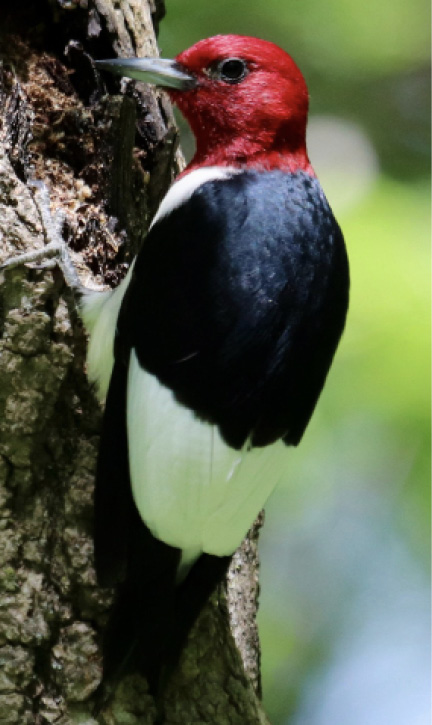
Red-headed woodpeckers live from the central to eastern United States, and in the lower tip of Canada. They are small compared to some other species within the same family. Their diet consists of a wide variety of insects, spiders, earthworms, nuts, seeds, berries, wild and cultivated fruit and occasional small mammals. Red-headed woodpeckers are also known to eat the young or the eggs from the nests of bluebirds and house sparrows, and they sometimes even consume bark. They prefer open woodlands, forest edges, clearings, and habitats with few tall, large-diameter trees. You can find these birds in river bottoms, open woods, orchards, parks, savannas, and prairies. Red-headed woodpeckers do not migrate in winter, but prefer mature forests containing larger, older trees where they can find an abundance of food, most notably acorns.
To listen to the vocalization of a red-headed woodpecker, and to learn more about the bird, go to Cornell University’s Ornithology Lab and its All About Birds site.
Woodpeckers of the Prairie: Downy Woodpecker
Picoides pubescens
The Downy woodpecker is the smallest native woodpecker to North America, with a length of five to seven inches. They are mostly black and white, with white stripes and spots throughout their entire body. They are a monogamous species with a life expectancy of 143 months.
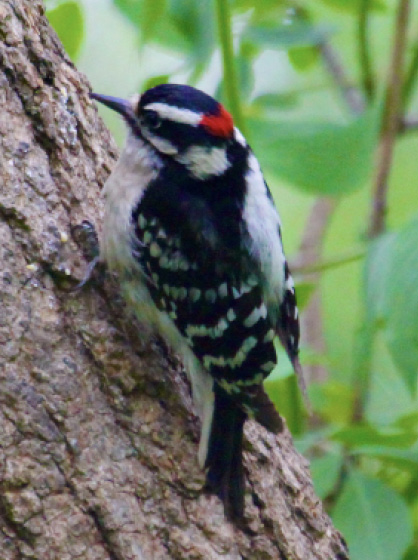
Photo taken May 19th, 2019, in Poweshiek County, Iowa, courtesy of Sandy Moffett
The downy is non-migratory and can be found throughout North America, from southeastern Alaska east to Newfoundland, Canada. Their range extends south to southern California and Florida. In the northern part of their habitat range, downy woodpeckers mostly reside in forests and woodlands. They’re also common in cultivated areas such as orchards, and can even be found in urban and suburban areas. In the southern region of the U. S., they prefer the woods or moist, aspen-willow stands. Their diet consists of insects and other arthropods, fruits, seeds, sap, beetles, weevils, ants, plant lice, caterpillars, scale insects, spiders, and suet from backyard feeders.
To listen to the vocalization of a downy woodpecker, and to learn more about the bird, go to Cornell University’s Ornithology Lab and its All About Birds site.
Woodpeckers of the Prairie: Red-Bellied Woodpecker
Melanerpes carolinus
Red-bellied woodpeckers are characterized by the bold black-and-white zebra patterns on their backs and—of course, given their name—some red on the abdomen, as well as bright, distinctive red coloring on the crown and nape of the neck. They also have long, chisel-shaped beaks. They are monogamous and have an average life expectancy of 145 months.
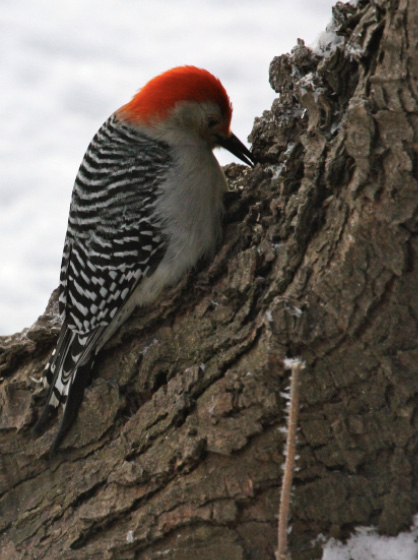
Photo taken March 3,2013, in Poweshiek County, Iowa, courtesy of Sandy Moffett
Red-bellied woodpeckers are non-migratory and can be found in the eastern half of the United States, including the prairie region. They are adaptable to various temperate forested habitats, but typically reside below 600 meter elevations in mature hardwood forests, mixed pine-hardwood forests, mesic pine flatwoods, heavily timbered bottomlands, swampy woods, and riparian forests. Their diet includes a wide variety of fruits, nuts, seeds, berries and tree sap, as well as ants, flies, grasshoppers, beetle larvae, caterpillars, brown and green anole lizards, tree frogs, small fish, nestling birds, and bird eggs.
To listen to the vocalization of a red-bellied woodpecker, and to learn more about the bird, go to Cornell University’s Ornithology Lab and its All About Birds site.
Woodpeckers of the Prairie: Northern Flicker
Colaptes auratus
The northern flicker is identifiable by its unique gray-brown barred back and white rump. They are a monogamous species with a life expectancy of 110 months.
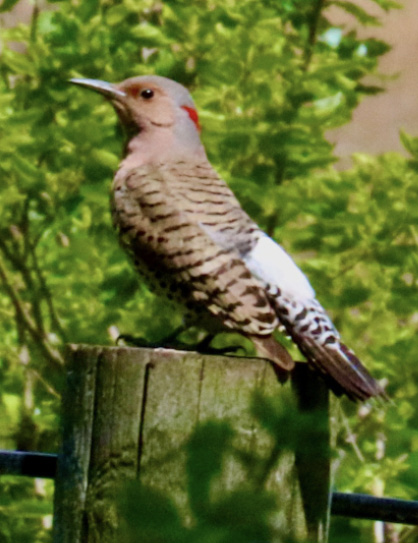
Photo taken May 30, 2017, in Poweshiek County, Iowa, courtesy of Sandy Moffett
The northern flicker is a migratory species, with habitats ranging from Alaska eastward to Quebec, then south throughout the United States to northern Mexico. They can also be found in Cuba and range as far as Nicaragua. During winter they prefer the southern part of this range and northern Mexico because of warmer climates. They live in wooded areas that have stands of dead trees, open areas, forest edges, burnt areas, agricultural lands, and residential areas. Their diet consists primarily of ants, however, they also consume grasshoppers, crickets, termites, wasps, aphids, beetles and their larvae, caterpillars, spiders, cherries, the berries of dogwood, Virgina creeper, poison ivy, sumac, hackberry, blackgum, weed seeds, acorns, and other types of nut kernels.
To listen to the vocalization of a northern flicker, and to learn more about the bird, go to Cornell University’s Ornithology Lab and its All About Birds site.
Woodpeckers of the Prairie: Pileated Woodpecker
Dryocopus pileatus
The pileated woodpecker is the largest woodpecker in North America, with a wingspan of up to 30 inches, which makes it comparable in size to the crow. They’re distinguishable by their large, dull black body and red crest. The life expectancy of this species is approximately 155 months.

Photo taken November 4th, 2021 in Mahaska County, Iowa, courtesy of Sandy Moffett
The prefered habitat of this non-migratory bird is mature deciduous woodlands of nearly every type. You can find them across Canada and the U.S., from the Northwest to forests in New England, to the swamps of the Southeast. They prefer nesting close to streams and in hollow trees with multiple entrances. Their primary food source is carpenter ants, but they also feed on other insects as well as fruits and nuts.
To listen to the vocalization of a Pileated woodpecker, and to learn more about the bird, go to Cornell University’s Ornithology Lab and its All About Birds site.
Woodpeckers of the Prairie: Hairy Woodpecker
Picoides villosus
The hairy woodpecker has black and white streakings on the wings, with white outer tail feathers. The males have a red patch on the back of the head, a black crown, and black eye mask and nape of the neck.
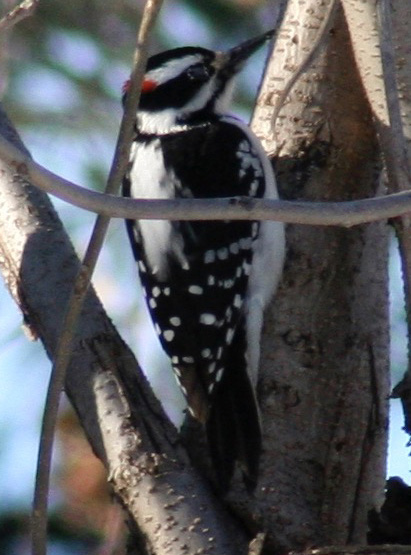
Photo taken Febuarary 21st, 2013, in Poweshiek County, Iowa, courtesy of Sandy Moffett
The hairy woodpecker can be found throughout most of North America, ranging from Alaska to Newfoundland, Canada, and southern Mexico to Florida. In the eastern United States, they can be found in all types of forests. They can be found in forested areas and gather socially where dead trees stand. In the northwestern region, they can be found in western hemlock forests, open juniper woodlands, and in riparian forests. They can also be found in gardens and residential areas.
Some northern residents migrate south during the winter to Guatemala, Costa Rica, and Panama.
To listen to the vocalization of a hairy woodpecker, and to learn more about the bird, go to Cornell University’s Ornithology Lab and its All About Birds site.

Sandy Moffett, Professor Emeritus of Theatre at Grinnell College, joined the faculty in 1971 and continues to teach and direct plays on campus on occasion. Currently he spends most of his time restoring prairie, writing songs and stories, performing with The Too Many String Band, and catering to the whims of his grandchildren. His writing has appeared in The Wapsipinicon Almanac and Salt Water Sportsman, and he has frequently published his writing, photography and music in Rootstalk, in
- Volume VI, Issue 1 (Spring 2020)
- Volume V, Issue 2 (Spring 2019)
- Volume III, Issue 2 (Spring 2017)
- Volume III, Issue 1 (Fall 2016) and
- Volume II, Issue 1 (Fall 2015)
 biologist with the U.S. Geological Survey's [Eastern Ecological Science Center.](https://www.usgs.gov/centers/eesc)](https://rootstalk.blob.core.windows.net/rootstalk-2022-spring/villatoro-9-volume-viii-issue-1-spring-2022.jpg)
The one that got away. The yellow-bellied sapsucker is the only woodpecker native to the prairie that has thus far eluded Sandy Moffett’s lens. Photo captured at a bird-banding event by Chelsea Steinbrecher-Hoffmann, biologist with the U.S. Geological Survey’s Eastern Ecological Science Center.
